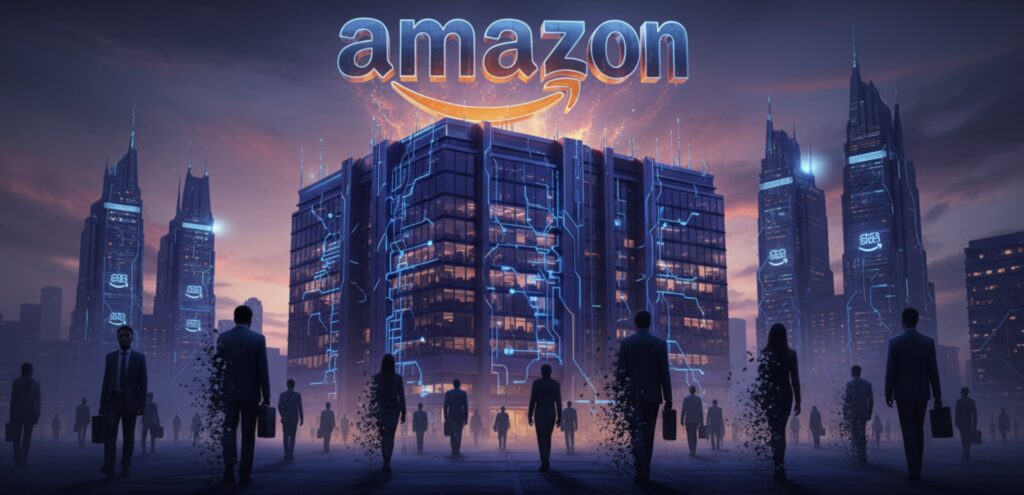As the Fed Slashes Rates, the Chair Warns That Artificial Intelligence Is Fueling Growth Without Jobs, Creating a Tricky Economic Tightrope
- The AI-Driven Hiring Freeze: Federal Reserve Chair Jerome Powell highlights how companies are increasingly citing AI as a reason for layoffs and hiring pauses, leading to near-zero job creation despite a seemingly healthy labor market.
- Economic Growth Amid Risks: While AI investments in data centers and infrastructure drive moderate expansion, the Fed faces a policy dilemma with upside risks to inflation and downside threats to employment.
- A Bifurcated Economy Emerges: The U.S. is splitting into a K-shaped recovery, where higher-income groups and corporations benefit from productivity gains, but lower-income consumers struggle, complicating the Fed’s balancing act.
In his latest press conference following the Federal Open Market Committee (FOMC) meeting on October 29, 2025, Federal Reserve Chair Jerome Powell delivered a stark assessment of the U.S. labor market, one that masks underlying fragility behind seemingly positive headlines. With unemployment at 4.3% and consumer spending remaining solid, the surface appears stable. However, Powell emphasized that after adjusting for statistical overcounting in payroll data, “job creation is pretty close to zero.” This slowdown, he linked directly to the rise of artificial intelligence, as CEOs increasingly tout AI’s ability to enhance efficiency with fewer workers.
Powell’s remarks underscore a transformative moment in the economy, where technological advancements are decoupling growth from job creation. He noted that a “significant number of companies” have announced layoffs or hiring freezes, often explicitly attributing them to AI. “Much of the time they’re talking about AI and what it can do,” Powell told reporters, adding that major employers are indicating they may not expand headcounts for years. The Fed is monitoring this closely, as it complicates their dual mandate of maximum employment and stable prices.
These insights arrived alongside the Fed’s decision to cut interest rates by a quarter point, lowering the benchmark to a 3.75%–4% range, citing “downside risks to employment” amid persistent inflation. Powell described the economy as expanding at a “moderate pace” despite waning hiring momentum. A major bright spot? Surging investments in AI infrastructure, such as data centers and related equipment, which he called one of the “big sources of growth in the economy.” In the first half of 2025 alone, AI-related capital expenditures contributed 1.1% to GDP growth, outpacing traditional consumer-driven expansion.
Defending against bubble comparisons, Powell drew a sharp contrast with the dot-com era, pointing out that today’s AI firms “actually have earnings.” These long-term productivity bets are less sensitive to interest rates, he argued, fostering sustainable growth rather than speculative frenzy. Globally, private AI investment hit a record high in 2025 with 26% growth, and the U.S. has widened its lead, capturing the lion’s share of funding. Yet, this boom presents a policy conundrum: AI boosts output but enables companies to operate with leaner staffs, softening the labor market even as GDP holds steady.
“We have upside risks to inflation, downside risks to employment,” Powell stated, highlighting the challenge for central bankers where one factor demands lower rates and the other higher. This tension is amplified by a bifurcated market, where recent corporate actions vividly illustrate the warnings. Amazon, for instance, is targeting up to 30,000 corporate job cuts—its largest since 2022—amid aggressive AI investments to streamline operations. Other firms like Target, Paramount, Intel, Microsoft, and Google have followed suit, contributing to a wave of tech layoffs.
According to Challenger, Gray & Christmas, U.S. employers announced nearly 950,000 layoffs through September 2025—the highest since 2020—with over 17,000 directly linked to AI and 20,000 to automation. In the tech sector alone, 591 layoffs events have impacted 177,275 workers so far this year. Globally, firms are slashing jobs amid weak sentiment and AI pushes, with American companies announcing over 25,000 cuts in October alone, excluding major figures like UPS’s 48,000. Powell reiterated, “Job creation is very low, and the job-finding rate for people who are unemployed is very low.”
This “Great Freeze”—a term coined by economists for the stagnant labor conditions—hits hardest at entry levels, where AI threatens to automate office jobs. Unemployment among recent college grads exceeds 5%, prompting many Gen Z workers to pursue graduate school as a “strategic timeout.” However, not all views align; some analyses suggest AI is creating more jobs than it displaces, with employment rising in AI-adopting sectors. A Goldman Sachs survey found only 11% of companies actively linking layoffs to AI, hinting the full impact may still unfold.
At the heart of the Fed’s deliberations is this awkward imbalance: robust AI investments propel growth, but hiring lags. Powell described the economy as increasingly K-shaped, with higher-income households and corporations thriving on stock gains and productivity boosts, while lower-income groups retreat under cost pressures. Anecdotal evidence from retailers shows a “bifurcated economy,” where the wealthy spend freely, but those at the bottom opt for cheaper alternatives. “Consumers at the lower end are struggling and buying less and shifting to lower-cost products,” Powell noted, complicating the Fed’s path.
As Big Tech ramps up spending—projected at nearly $400 billion in 2025, with firms like Microsoft eyeing $80 billion and Amazon $125 billion—the AI buildout shows no slowdown. Yet, this could spell investor risks if productivity gains don’t materialize, potentially inflating a bubble despite Powell’s assurances. “There is no risk-free path for policy,” Powell concluded. “We’re navigating the tension between our employment and inflation goals as carefully as we can.” From a broader lens, this AI-driven shift challenges not just U.S. policymakers but global economies, where automation could exacerbate inequalities. While AI’s potential to add trillions in value is tantalizing—estimates peg $8 trillion for the U.S. alone—the human cost demands proactive measures like retraining and inclusive growth strategies. As the Fed adapts meeting-by-meeting, the hiring apocalypse Powell describes may redefine work, urging society to ensure technological progress benefits all, not just the elite.

